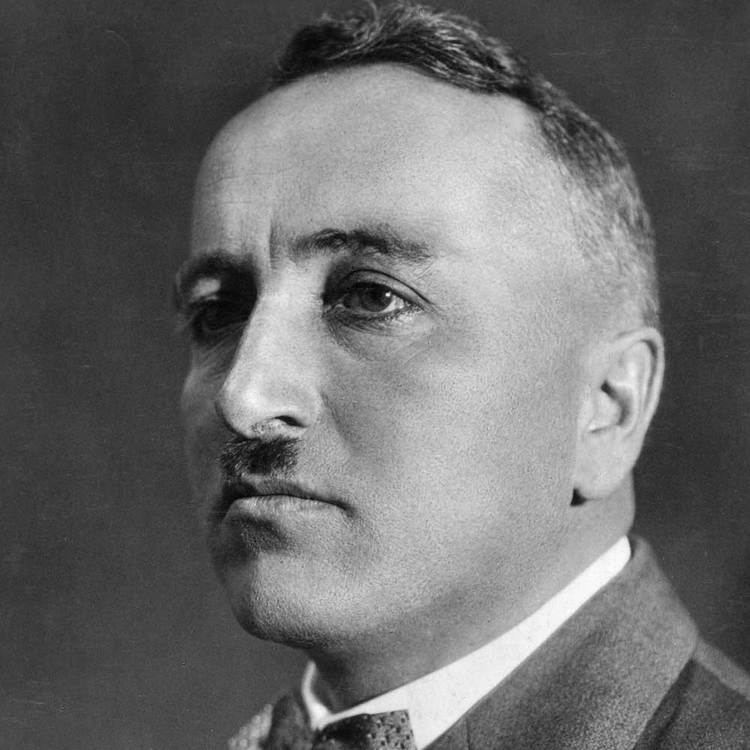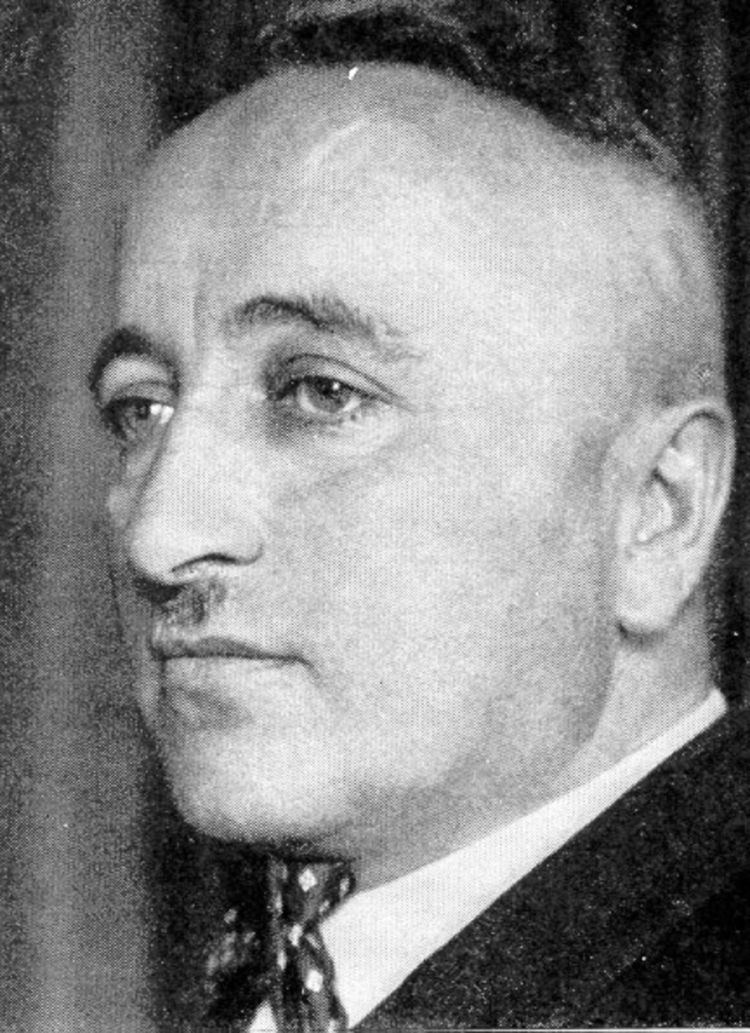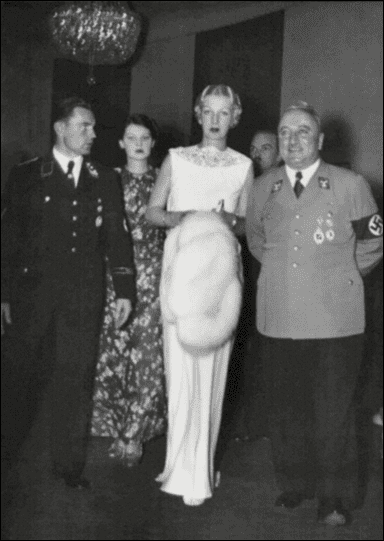Role Politician | Nationality German Name Robert Ley | |
 | ||
Political party National Socialist German Workers' Party (NSDAP) Spouse(s) Elisabeth Schmidt (? – 1938)Inge Spilcker (1938–1942)Madeleine Wanderer (mistress) Children Renate Wald (29 July 1922 – 2004)Lore (25 October 1938)Wolf (14 May 1940)Gloria (27 June 1941)Rolf Robert (28 July 1944) Parents Friedrich Ley, Emilie Wald Similar People Hermann Goring, Dietrich Eckart, Adolf Hitler, Anton Drexler, Arthur Lange | ||
John dolibois on robert ley
Robert Ley ( [ˈlaɪ]; 15 February 1890 – 25 October 1945) was a German politician during the Nazi era who headed the German Labour Front from 1933 to 1945. He committed suicide while awaiting trial at Nuremberg for war crimes.
Contents
- John dolibois on robert ley
- Hitler on robert ley 1939
- Early life
- Labour Front head
- Strength Through Joy
- Wartime role
- Post war
- References

Hitler on robert ley 1939
Early life

Ley was born in Niederbreidenbach (now a part of Nümbrecht) in the Rhine Province, the seventh of 11 children of a heavily indebted farmer, Friedrich Ley, and his wife Emilie (née Wald). He studied chemistry at the universities of Jena, Bonn, and Münster. He volunteered for the army on the outbreak of World War I in 1914 and spent two years in the artillery before training as an aerial artillery spotter with Field Artillery Detachment 202. In July 1917 his aircraft was shot down over France and he was taken prisoner. It has been suggested that he suffered a traumatic brain injury in the crash; for the rest of his life he spoke with a stammer and suffered bouts of erratic behaviour, aggravated by heavy drinking.

After the war Ley returned to university, gaining a doctorate in 1920. He was employed as a food chemist by a branch of the giant IG Farben company, based in Leverkusen in the Ruhr. Enraged by the French occupation of the Ruhr in 1924, Ley became an ultra-nationalist and joined the Nazi Party soon after reading Adolf Hitler's speech at his trial following the Beer Hall Putsch in Munich. By 1925 he was Gauleiter of the Southern Rhineland district and editor of a virulently anti-Semitic Nazi newspaper, the Westdeutsche Beobachter. Ley proved unswervingly loyal to Hitler, which led the party leader to ignore complaints about his arrogance, incompetence and drunkenness.
Labour Front head

In 1931, Ley was brought to the Nazi Party's Munich headquarters to take over as head of the party organisation (Reichsorganisationsleiter) following Hitler's dismissal of Gregor Strasser in an internal dispute. Ley's impoverished upbringing and his experience as head of the largely working-class Ruhr party region meant that he was sympathetic to those elements in the party who were open to socialism, which Hitler opposed, but he always sided with Hitler in inner party disputes. This helped him survive the hostility of other party officials such as the party treasurer, Franz Xaver Schwarz, who regarded him as a drunken incompetent. When Hitler became Chancellor in January 1933, Ley accompanied him to Berlin. In April, when the trade union movement was taken over by the state, Hitler appointed him head of the German Labour Front (Deutsche Arbeitsfront, DAF).

The DAF took over the existing Nazi trade union formation, the National Socialist Factory Cell Organisation (Nationalsozialistische Betriebszellenorganisation, NSBO) as well as the main trade union federation. But Ley's lack of administrative ability meant that the NSBO leader, Reinhold Muchow, a member of the socialist wing of the Nazi Party, soon became the dominant figure in the DAF, overshadowing Ley. Muchow began a purge of the DAF administration, rooting out ex-Social Democrats and ex-Communists and placing his own militants in their place.
The NSBO cells continued to agitate in the factories on issues of wages and conditions, annoying the employers, who soon complained to Hitler and other Nazi leaders that the DAF was as bad as the Communists had been.
Hitler had no sympathy with the syndicalist tendencies of the NSBO, and in January 1934 a new Law for the Ordering of National Labour effectively suppressed independent working-class factory organisations, even Nazi ones, and put questions of wages and conditions in the hands of the Trustees of Labour (Treuhänder der Arbeit), dominated by the employers. At the same time Muchow was purged and Ley's control over the DAF re-established. The NSBO was completely suppressed and the DAF became little more than an arm of the state for the more efficient deployment and disciplining of labour to serve the needs of the regime, particularly its massive expansion of the arms industry.
Once his power was established, Ley began to abuse it in a way that was conspicuous even by the standards of the Nazi regime. On top of his generous salaries as DAF head, Reichsorganisationsleiter, and Reichstag deputy, he pocketed the large profits of the Westdeutsche Beobachter, and freely embezzled DAF funds for his personal use. By 1938 he owned a luxurious estate near Cologne, a string of villas in other cities, a fleet of cars, a private railway carriage and a large art collection. He increasingly devoted his time to "womanising and heavy drinking, both of which often led to embarrassing scenes in public." On 29 December 1942 his second wife Inge (1916–1942) shot herself after a drunken brawl. Ley's subordinates took their lead from him, and the DAF became a notorious centre of corruption, all paid for with the compulsory dues paid by German workers. One historian says: "The DAF quickly began to gain a reputation as perhaps the most corrupt of all the major institutions of the Third Reich. For this, Ley himself had to shoulder a large part of the blame."
Strength Through Joy
Hitler and Ley were aware that the suppression of the trade unions and the prevention of wage increases by the Trustees of Labour system, when coupled with their relentless demands for increased productivity to hasten German rearmament, created a real risk of working-class discontent. In November 1933, as a means of preventing labour disaffection, the DAF established Strength Through Joy (Kraft durch Freude, KdF), to provide a range of benefits and amenities to the German working class and their families. These included subsidised holidays both at resorts across Germany and in "safe" countries abroad (particularly Italy). Some of the world's first purpose built cruise-liners, the Wilhelm Gustloff and the Robert Ley, were built to take KdF members on Mediterranean cruises.
Other KdF programs included concerts, opera and other forms of entertainment in factories and other workplaces, free physical education and gymnastics training and coaching in sports such as football, tennis and sailing. All this was paid for by the DAF, at a cost of 29 million Reichsmarks a year by 1937, and ultimately by the workers themselves through their dues, although the employers also contributed. KdF was one of the Nazi regime's most popular programs, and played a large part in reconciling the working class to the regime, at least before 1939.
The DAF and KdF's most ambitious program was the "people's car," the Volkswagen, originally a project undertaken at Hitler's request by the car-maker Ferdinand Porsche. When the German car industry was unable to meet Hitler's demand that the Volkswagen be sold at 1,000 Reichsmarks or less, the project was taken over by the DAF. This brought Ley's old socialist tendencies back into prominence. The party, he said, had taken over where private industry had failed, because of the "short-sightedness, malevolence, profiteering and stupidity" of the business class. Now working for the DAF, Porsche built a new Volkswagen factory at Fallersleben, at a huge cost which was partly met by raiding the DAF's accumulated assets and misappropriating the dues paid by DAF members. The Volkswagen was sold to German workers on an installment plan, and the first models appeared in February 1939. The outbreak of war, however, meant that none of the 340,000 workers who paid for a car ever received one. The entire project was financially unsound, and only the corruption and lack of accountability of the Nazi regime made it possible.
Wartime role
Ley said in a speech in 1939: "We National Socialists have monopolized all resources and all our energies during the past seven years so as to be able to be equipped for the supreme effort of battle." With the outbreak of World War II in September 1939, Ley's importance declined. The militarisation of the workforce and the diversion of resources to the war greatly reduced the role of the DAF, and the KdF was largely curtailed. Ley's drunkenness and erratic behaviour were less tolerated in wartime, and he was supplanted by Armaments Minister Fritz Todt and his successor Albert Speer as the czar of the German workforce (the head of the Organisation Todt (OT)). As German workers were increasingly conscripted, foreign workers, first "guest workers" from France and later slave labourers from Poland, Ukraine and other eastern countries, were brought in to replace them. Ley played some role in this program, but was overshadowed by Fritz Sauckel, General Plenipotentiary for the Distribution of Labour (Generalbevollmächtigter für den Arbeitseinsatz), in 1942.
Nevertheless, Ley was deeply implicated in the mistreatment of foreign slave workers. In October 1942 he attended a meeting in Essen with Paul Plieger (head of the giant Hermann Göring Works industrial combine) and leaders of the German coal industry. A verbatim account of the meeting was kept by one of the managers. A recent historian writes:
The key item on the agenda was the question of 'how to treat the Russians.' ... Robert Ley, as usual, was drunk. And when Ley got drunk he was prone to speak his mind. With so much at stake, there was no room for compassion or civility. No degree of coercion was too much, and Ley expected the mine managers to back up their foremen in meting out the necessary discipline. As Ley put it: 'When a Russian pig has to be beaten, it would be the ordinary German worker who would have to do it.'
Despite his failings, Ley retained Hitler's favour; until the last months of the war he was part of Hitler's inner circle along with Martin Bormann and Joseph Goebbels. In November 1941 he was given a new role, as Reich Commissioner for Social House-Building (Reichskommissar für den sozialen Wohnungsbau), later shortened to Reich Housing Commissioner (Reichswohnungskommissar). Here his job was to prepare for the effects on German housing of the expected Allied air attacks on German cities, which began to increase in intensity from 1941 onwards. In this role he became a key ally of Armaments Minister Albert Speer, who recognised that German workers must be adequately housed if productivity was to be maintained. As the air war against Germany increased from 1943, "dehousing" German workers became an objective of the Allied area bombing campaign, and Ley's organisation was increasingly unable to cope with the resulting housing crisis.
He was aware in general terms of the Nazi regime's programme of extermination of the Jews of Europe. Ley encouraged it through the virulent anti-Semitism of his publications and speeches. In February 1941 he was present at a meeting along with Speer, Bormann and Field Marshal Wilhelm Keitel at which Hitler had set out his views on the "Jewish question" at some length, making it clear that he intended the "disappearance" of the Jews one way or another.
In May 1944, Ley addressed a nationwide gathering of merchants in Passau.
Post-war
As Nazi Germany collapsed in early 1945, Ley was among the government figures who remained fanatically loyal to Hitler. He last saw Hitler on 20 April 1945, Hitler's birthday, in the Führerbunker in central Berlin. The next day he left for southern Bavaria, in the expectation that Hitler would make his last stand in the "National Redoubt" in the alpine areas. When Hitler refused to leave Berlin, Ley was effectively unemployed. On 16 May he was captured by American paratroopers of the 101st Airborne Division in a shoemaker's house in the village of Schleching. Ley told them he was "Dr. Ernst Distelmeyer," but he was identified by Franz Xaver Schwarz, the treasurer of the Nazi Party and a long-time enemy.
At the Nuremberg Trials, Ley was indicted under Count One ("The Common Plan or Conspiracy to wage an aggressive war in violation of international law or treaties"), Count Three (War Crimes, including among other things "mistreatment of prisoners of war or civilian populations") and Count Four ("Crimes Against Humanity – murder, extermination, enslavement of civilian populations; persecution on the basis of racial, religions or political grounds"). Ley was apparently indignant at being regarded as a war criminal, telling the American psychiatrist Douglas Kelley and psychologist Gustave Gilbert who had seen and tested him in prison: "Stand us against a wall and shoot us, well and good, you are victors. But why should I be brought before a Tribunal like a c-c-c- ... I can't even get the word out!"
On 24 October, three days after receiving the indictment, Ley strangled himself in his prison cell using a noose made by tearing a towel into strips, fastened to the toilet pipe in his cell.
